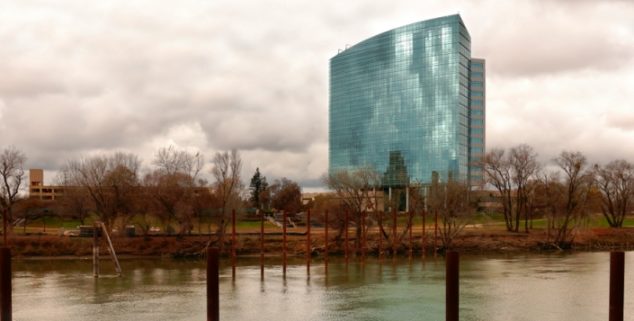Opinion
Amid roiled market, public pension funds’ declines not unexpected
 A view across the river of the CalSTRS headquarters in West Sacramento. (Photo: ImageAllan, via Shutterstock)
A view across the river of the CalSTRS headquarters in West Sacramento. (Photo: ImageAllan, via Shutterstock)California’s two public employee pension funds, the nation’s largest, have reported a decline in their investments for the fiscal year just ended. To anyone who’s even casually followed recent economic news, the results should not be surprising. It’s been a down year on Wall Street.
The Standard & Poor’s 500 Index recorded its worst first half of the year in 50 years, falling nearly 20 percent. The pension funds are significantly invested in equity markets, and their returns followed the same downward curve, though outperformed the market as a whole.
These funds are built for the long term, and their investment horizon spans decades.
How should Californians react to the headlines about investment losses recorded by the California Public Employees Retirement System (CalPERS) and the California State Teachers Retirement System (CalSTRS)?
Here’s the best advice: To the more than 3 million retirees, teachers, firefighters, nurses, police officers and other state and local government employees who rely on the state’s two largest pension funds: Do not be alarmed.
To the critics who periodically predict – always following downward swings in the stock market – that the pension funds will someday not be able to meet their obligations: Do not be alarmist.
That there will be years of negative returns is a fact of life for pension investment funds. The assumption is built into the system. There is no cause for panic when such a year arrives, just as last year there was no cause for celebration when CalPERS registered a 21 percent positive return and CalSTRS recorded a record-breaking 27 percent gain.
These funds are built for the long term, and their investment horizon spans decades. They are managed under the assumption that annual returns will average 6.8 percent at CalPERS and 7 percent at CalSTRS over the long haul, and that’s below what they’ve actually achieved. Over the past 30 years, the average annualized return at CalPERS has been 8.4 percent. For CalSTRS, that number stands at 8.6 percent.
Members and beneficiaries of the pension funds are protected by the long-term investment horizon of those funds and are not at the mercy of bad timing.
Over those 30 years the funds have prospered in good times and weathered some very bad times – none worse than the calamitous 2008 financial meltdown that triggered a stunning 48 percent decline in the S&P 500. Even with that shock, however, the funds’ performance over the last 20 years has met the assumed return – 6.9 percent at CalPERS, 7.6 percent at CalSTRS.
During those difficult years of the Great Recession, it became politically popular for some to stir fear and resentment about public employee pensions. They called for radical changes, such as moving away from the defined benefit model of retirement security and replacing it with a 401(k)-type system for those who educate our children, care for our sick and respond to our emergencies.
Perhaps some will try to seize on this latest one-year snapshot to reprise those calls. Their proposals were faulty then and would be even more so now. The Center for Retirement Security estimates that 401(k) losses so far this year amount to about $1.2 trillion – a hit that puts financial security at risk for those who have recently retired or are approaching retirement.
Members and beneficiaries of the pension funds are protected by the long-term investment horizon of those funds and are not at the mercy of bad timing that results in their retirement savings eroding just at the time when they are needed.
The retirement security provided by the public sector is more important now than ever. Our schools face a critical shortage of teachers, our public hospitals and clinics are scrambling to find enough nurses and healthcare professionals, and CalFIRE has been unable to fill essential positions even as another horrific wildfire season is upon us.
The promise of retirement security is an inducement to attract a new generation into public service just when those workers are desperately needed. Don’t let the headlines about one-year losses cause alarm. These retirement plans are secure – for those who rely on them now, and for those who will rely on them 30 years from now. They’re built to withstand such ups and downs.
—
Editor’s Note: Ted Toppin chairs Californians for Retirement Security, a 1.6 million-member organization of public employee unions and retirees.
Want to see more stories like this? Sign up for The Roundup, the free daily newsletter about California politics from the editors of Capitol Weekly. Stay up to date on the news you need to know.
Sign up below, then look for a confirmation email in your inbox.

Leave a Reply